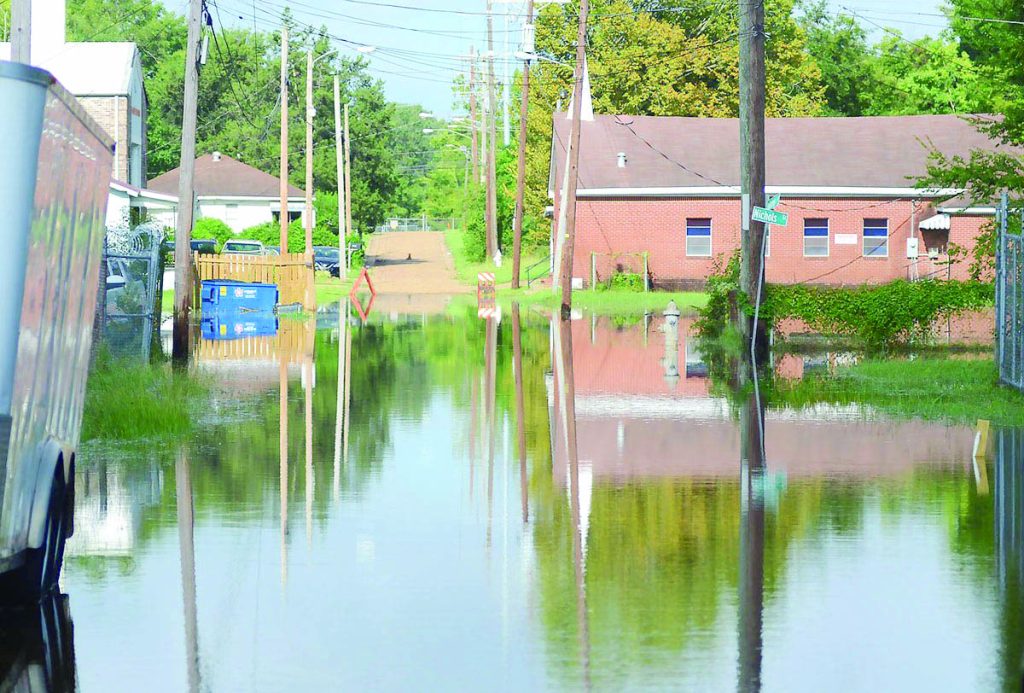By Jimmie E. Gates
MS Center for Investigative Reporting
First in a three-part series
Mississippi has 75,000 people living in regions at risk of coastal flooding. An additional 13,000 more could be at risk by 2050 because of the rising sea level, and that doesn’t include residents living inland who’ve already withstood repeated devastating flooding.
Those are conclusions in a report released in 2021 by The Climate Reality Project, founded by former Vice President Al Gore, and echoed by the Environmental Protection Agency.
At the same time, some of the communities hardest hit by hurricanes, floods and wildfires are not getting government assistance to adapt to climate change or move out of harm’s way, an analysis of federal data on natural disasters and related aid by Columbia Journalism Investigations and its partners. Some have applied for federal funding and been denied – at times more than once – only to be forced to flee from repeated hurricanes, floods and wildfires. Others face institutional and political barriers to seeking aid because a lot of communities in need of help don’t have the infrastructure to apply for grants, assuming they’d even qualify.
The Center for Public Integrity said, if a place has a single emergency management staffer, that person usually won’t have the capacity to research and apply for these grants – and there are places that don’t even have that role.
“The political barriers our reporters found include a widespread disinclination to plan for the need to move people,” said Jamie Hopkins, editor of the Center for Public Integrity.
Diana Bernstein, assistant professor in the Division of Marine Science at the University of Southern Mississippi, said in Mississippi, the results of climate change, have been more flood-producing storms; more extreme weather events, such as tropical storms; and measurable sea-level rise in the Gulf of Mexico.
“In Mississippi, if current trends persist, we will experience on average hotter temperatures, more flood-producing storms, coastal seal-level rise, ocean acidification, and more hurricanes and extreme weather events, among other impacts,” said Bernstein, who has studied climate change. “Across the country, if current trends persist, we will see many of these same effects, including more extreme rain, along with severer droughts and fiercer wildfires in many places.”
On a practical level, for Mississippians, climate change could result in many other noticeable differences, like longer mosquito seasons, more flash flood-producing storms in the Mississippi River Basin (which will likely require the opening of the Mississippi River spillways and cause catastrophic damage to fisheries, oyster hatcheries, and marine life), and more days where temperatures are unbearably hot,” Bernstein said.
On a planning level, Bernstein said she believes Mississippi’s leaders need to do much more to account for many areas of Mississippi, especially along the coast and in flood-prone areas, becoming uninhabitable in the coming decades, and possibly sooner. “We also need to stop burning fossil fuels now if we want to have any realistic chance of avoiding the worst impacts of climate change, especially in Mississippi,” she said.
The Climate Reality Project says more intense hurricanes will become a reality in Mississippi and there could be more than 100 days a year with temperatures above 100 degrees by the end of the century – four times more than the current 15 to 25 days the state now experiences.
The Environmental Protection Agency noted Mississippi will become warmer, with floods and droughts likely more severe in the future due to climate change. Annual rainfall has increased, more rain arrives in heavy downpours, and the sea level is rising about one inch every seven years, the EPA said in a recent report. The changing climate is likely to increase damages from tropical storms, reduce crop yields, harm livestock, increase the number of unpleasantly hot days, and increase the risk of heat stroke and other heat-related illnesses.
The Climate Reality Project says communities close to the Mississippi River also are vulnerable to inland flooding because increasing precipitation and heavy rain events raise the overall flood risk, causing disruption to transportation, drinking water contamination, evacuations, damage to buildings, injuries and death.
Heavy downpours and flooding in the waning days of August in Jackson have helped to cripple the capital city’s already fragile water system, leaving many of its 180,000 residents without even running water.
In 2019, states along the Mississippi River experienced devastating flooding that lasted from spring through July, the longest since the Great Flood of 1927, according to The Climate Reality Project. In the southern part of the Mississippi Delta, about 700 homes were flooded and more than 500,000 acres left underwater. Families in the Delta community of Schlater, with approximately 300 residents, were left without running water for more than a year, lacking water even to flush their toilets after the community’s only water well was irreparable.
The community secured a grant from the U.S. Department of Health and Human Services to build a new well to restore water to the community.
The Geoscience Department at Mississippi State University says the state is subject to periods of drought and flood, and the climate rarely seems to bring “average” conditions. It’s feast or famine, department officials say about the fickle nature of the state’s climate.
“I don’t know if it’s global warming or not, but my perspective as emergency management director working in this area is that we have seen a lot more severe weather over the past several years than we had in the past,” said Warren County Emergency Management Director John Elfer, whose county saw historic flooding in 2019 and 2011 in the Eagle Lake community and surrounding areas.
Mississippi Emergency Management Agency spokeswoman Malary White said MEMA is aware of studies from scientists and government agencies that suggest increasing global surface temperatures will lead to the possibility of more droughts and increased intensity of storms.
“While we leave the predictions to the meteorologists, we take the threat of more severe weather seriously,” said White, MEMA’s chief communications officer.
But White said weather trends are ever evolving, and every disaster is different. In 2020 we experienced six federally declared disasters, including COVID-19; in 2021, two federally declared disasters; as of this year, Mississippi has not had one.
MEMA’s mission is to preserve the lives and properties of all Mississippians, and that goal will remain the same no matter the frequency of disasters, White said.
This story was produced as part of a collaboration with the Center for Public Integrity, Columbia Journalism Investigations and Type Investigations.
This story was produced by the Mississippi Center for Investigative Reporting, a nonprofit news organization that is exposing wrongdoing, educating and empowering Mississippians, and raising up the next generation of investigative reporters. Sign up for our newsletter: https://www.mississippicir.org/sign-up.






